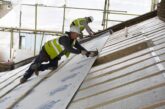
Kingpan explains how you can ready for the new Part L Building Regulations.
This year, England, Wales and Scotland are all introducing tougher energy efficiency requirements in their Building Regulations and Standards. These changes mean buildings will typically need to be insulated to a higher level. Installers in England and Wales will also need to fill out new compliance reports to prove that what you install matches up with the specification to help reduce the performance gap. To give a taste of these changes, let’s take a look at the expected requirements for new homes.
Key Changes
In England, the revised version of Part L to the Building Regulations has already been published. Wales and Scotland are due to publish updates to their own Building Regulations and Standards this Spring, but we have a good idea of what they’re likely to include from the consultations they ran last year.
Carbon emissions from new homes will need to be 31 per cent lower than under current standards in England, 37 per cent lower in Wales and either 32 per cent or 57 per cent lower in Scotland (depending on the outcome of the consultation). The countries are also adding new energy performance targets designed to limit overall demand. These targets can be offset with any power generated from onsite renewables, so PV roof panels may become a more common part of new builds.
The regulations also look to ensure that new homes are insulated to a high level. All three countries are significantly tightening the worst-case U-values that new projects have to meet (shown in the table below). The U-value is the thermal performance of a building element. The lower the U-value, the better insulated the construction needs to be. Keep in mind that these are the worst possible values. To be compliant, most homes will need to reach even lower U-values.
![]()
England also has a Fabric Energy Efficiency Standard (FEES) which sets the maximum heating/cooling demand for a building. The FEES target is calculated based on the Notional Dwelling specification (shown below) and is affected only by the U-values, thermal bridging values and airtightness of the property. This simply means that a good level of fabric performance is going to be essential for compliance.
The Notional Dwellings below give a good idea of what a compliant home may look like in each region when using a gas boiler.
![]()
The Scottish notional building options also include a heat pump notional package for each option, with the same fabric levels, but with no PV or WWHR where used.
These demanding U-values mean that the lambda value (thermal conductivity) of the insulation you use will be important. The lower this value is, the better the material is at stopping heat loss. This means you can often use a slimmer thickness of insulation to hit your target U-value, helping to keep constructions to a reasonable depth. Phenolic insulation boards typically have the lowest thermal conductivity of any commonly used insulation material.
Proving compliance
In addition to these targets, the new regulations are also looking to reduce heat loss from thermal bridges. These are areas where materials which are better conductors of heat than the insulation layer are allowed to form a ‘bridge’ between the inner and outer face of a construction – effectively acting as a fast-track for heat to escape. They commonly occur where there are gaps or inconsistencies in the insulation layer, such as junctions around windows and doors or between the walls, floor and roof.
In England and Wales, installers are going to need to take pictures of any measures they install before they are covered up. These will be included in new compliance reports which will be checked by Building Control to confirm that the insulation products you have fitted, and the way they are installed, match with the specification and detailing. Keep in mind that even insulation products which look similar on the shelf can have very different lambda values. This means substituting one product for another may lead to the building being deemed non-compliant.
Deadline Approaching
The new version of Part L 2021 in England is due to come into force for all buildings from June 15th and the updates are expected to be fully in force in all regions by the end of the year, so it is important to keep an eye on these changes and ensure your work meets all the new requirements, including improved thermal performance.
For more information on Kingspan insulation visit https://www.kingspan.com/gb/en-gb/about-us/kingspan-great-britain







